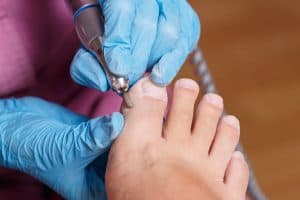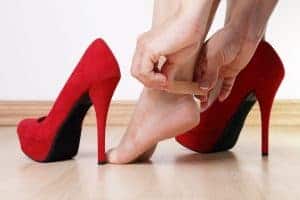Corns Callouses
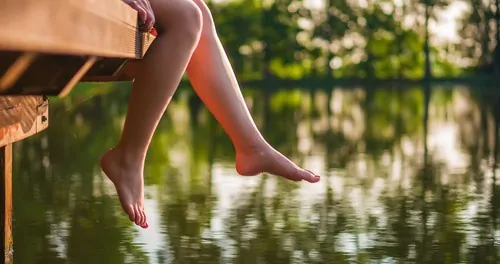
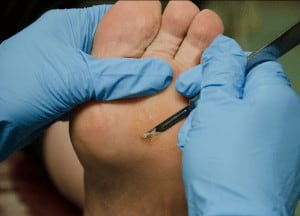
Corns – Corns ans callouses are among the most commonly treated foot conditions. Corns are the thickening of the skin on its outer layer around the toe’s tops, where callouses are similar condition but on the bottom of the feet. These conditions are caused from pressure and can be painful. Can be removed by your podiatrist with a scalpel, don’t try this at home! Be careful applying over the counter corn pads to
Corns Callouses
Basic information- define callus:
While they may be annoying and painful, corns and calluses usually aren’t harmful. In essence, both are areas of thickened skin which form as a protective response to chronic friction. The technical term for the hard, thickened skin which forms both calluses and corns is hyperkeratosis, or hyperkeratoses in plural. These terms are rarely used, and even among professionals these conditions are simply called corns and calluses.
Callus
In a callus, this protective response takes the form of a diffuse, broad-based patch of hardened skin. The technical term for a callus is tyloma. Calluses commonly form on the hands of manual workers such as farmers and construction workers. On the feet, calluses often form on the bottom of the heel and the ball of the foot. Anyone who walks or runs a lot can develop calluses on their feet.
Corns are much more localized, are generally thicker, and can be quite hard. They tend to take on a conical appearance, and are almost exclusively found on the feet. The technical term for corns is helomas or clavi. In some patients they take on a dry, waxy look, sometimes even appearing translucent.
Callouses meaning
Calluses are commonly found on both the hands and feet. In reality, any area subjected to repetitive friction can form a callus. While corns can also technically form anywhere, in the overwhelming majority of cases they’re found on specific locations of the feet. Calluses are generally painless, while corns have the potential to become quite painful. The following are common locations:
- The plantar surface (bottom) of the foot, is also known as the sole.
- When on the metatarsal arch, also known as the ball of the foot.
- On the lateral (outside) edge of the fifth toe, corns are known more commonly as the “pinky” or small toe. Most corns are located here, as this area is especially prone to repetitive friction.
Another relatively common location for corns is between the fifth toe (pinky) and the fourth toe. Instead of having a hard, conical appearance, corns located here are often softer and whitish. Not surprisingly, these are commonly known as “soft corns,” or beloma molle. “Hard corns,” or heloma durum, are usually found elsewhere on the foot
How do podiatrists remove callouses?
In many cases, they don’t have to. Corns, and especially calluses, often go away on their own once the source of friction is removed. Often simply buying shoes which fit properly is all that’s needed. If this isn’t enough, podiatrists can apply padding around the corn to relieve excessive rubbing. If these two methods fail, then a podiatrist will carefully shave away the corn or callus. Nearly all podiatrists advise against using store bought acid-based corn remover products.
Home remedies for corns and callouses
- Using a hot water bath, soak the foot for about 10 minutes. This will soften the surface of the corn.
- Using a fingernail file or pumice stone, carefully sand away the top surface of the corn.
- Don’t rush. This method will certainly take multiple treatments, but complete removal of the corn is possible.
Corns are an unnatural thickening and hardening of the skin over points of excessive rubbing and pressure. They form over time, and generally assume a cone-like shape. In many cases corns are harmless if unsightly, and don’t cause any problems or symptoms. If a corn is located on a weight-bearing area of the foot, however, they can be quite painful. Corns are among the most common conditions treated by podiatrists.
Corns aren’t good “do-it-yourself” opportunities. This is especially true of diabetics, as any form of trauma to the foot can have far-reaching negative consequences. Only a trained podiatrist should remove a corn, which often involves shaving them down.
Calluses are similar to corns in many ways, and are also one of the most common conditions seen in podiatrists’ offices. They are also a thickening and hardening response, and tend to form on the bottoms of the feet, particularly the ball of the foot and heel. Calluses are rarely painful, yet can require treatment if they’re overly thick or become cracked. As with corns, never try to shave down a callus yourself with any type of sharp instrument. Again, this holds especially true for diabetics.
Soft corn between 4th and 5th toe
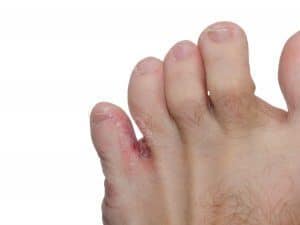
Where do foot corns develop?
The places where foot corns develop are varied. Below are listed common spots where you might encounter a foot corn:
- below your toenail
- between your toes
- on the sides or bottom of your feet
Corns and Calluses?
Corns and calluses are bothersome conditions that may form from the thickened areas of skin that experience constant and excessive pressure. Medically this is known as hyperkeratosis, which translates to “an excessive growth of skin”.While a callus typically refers to an area of skin that is flat and elongated, a corn is usually a section of skin that exhibits a more protruding excess of skin, often protruding in a circular bump. Corns, also called helomas or clavi, are often dry or waxy to the touch, and can be translucent. Calluses may also be referred to as tylomas.
What causes foot corns?
Corns can often develop when you are wearing constrictive shoes, standing or walking for a prolonged period of time, or on your feet bearing excessive loads. These can all cause painful corns on the bottom of the feet.
Another way to understand the definition of hyperkeratosis is that the skin thickens due to the pressure. This kind of thickening is a natural reaction to strengthen the skin against the friction or pressure. If there is an abnormality on your foot, you may be more prone to developing a corn or callus formation. Additionally, footwear that is restrictive can lead to certain spots of the foot to experience higher levels of friction. Finally, the way you walk, also known as your gait, may also affect the levels of pressure or friction on parts of your feet, leading to foot corns or calluses.
Treating and Preventing Corns on the Foot
Foot corns are when layers of the skin harden from friction and pressure. It’s likely that you may have foot corns if you experience any of the following symptoms on your toes:
- lumpy patches of skin that are yellow, and may be rough to the touch
- sensitive skin
- pain while wearing shoes
Luckily, there are treatments for foot corns, as well as helpful preventative measure you can adopt to minimize your chances of developing them. Here we will give a brief overview of what you can do about foot corns in your life.
Corns on the fingers can develop, but it is unsure why. Since the friction and pressure generally associated with corns are absent on most areas of the skin, these must be the byproduct of other influences, such as tool-work (pens, hammers, etc.), playing a musical instrument (the strings on a guitar), or doing repetitive and vigorous tasks with your hands.
While lifestyles will impact the likelihood of developing a corn/callus, there is a significant increase in likelihood in persons over the age of 65 years old, with 20-65% of persons experiencing this condition in their lifetime.
How can you treat foot corns and callouses ?
Should you develop a corn, there are a few at-home remedies you can try out. First you’ll want to isolate the factors that caused the corn to develop, and eliminate them if you can (swapping up for a new pair of shoes, wearing less constrictive socks, etc.). After that, you’ll want to shop around for medicated products aimed at chemically paring down the dead skin. There are many different types of products, but you’ll want to look for an active ingredient known as salicylic acid, which is commonly used in over-the-counter wart removal products.
Salicylic acid is what is known as a keratolytic, which is a substance that actively dissolves the keratin protein that corns and calluses are composed of. When used as directed, keratolytic products offer a safe and gentle treatment option for those looking to avoid a doctor’s visit, and are available in several forms, such as
- applicators
- drops
- pads
- plasters
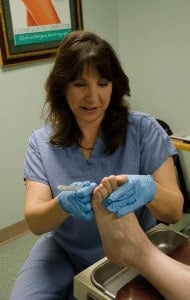
What are Foot Callouses and Corns?
Calluses and Corns are caused when your body experiences pressure or friction against the skin. When this happens, the skin that is affected thickens. For instance, if the foot rubs against the shoe, the affected area will build up, forming a sometimes-painful area that will begin to rub against shoes, socks and nylons. While very similar, there are noticeable differences among these skin conditions:
- Corns are thickened skin in the shape of a cone or circle
- Calluses are similar, expect that they are more spread out over the skin and are flatter in appearance.
- If your callus has black dots – it may be a plantars wart- see a Foot Dr immediately!
Where Do Foot Corns and Calluses Form?
Corns and calluses often form at different places on the feet, since there is so much pressure exerted there, including:
- Over the ball of foot, on the sole
- Between the fourth and fifth (pinky) toe
- On the outside of the baby toe
- Hard skin on the top of the second toe
Sometimes, a bone in your foot is out of the normal position. The skin that is caught between the bone and shoe or the bone and the ground will begin to thicken to protect the foot from pressure. As the skin thickens, it can become painful.
There are several reasons why painful corns and calluses form:
- Problems with the positions of your toes (such as hammertoes and bunions) or a malformation on your foot
- An irregular gait that causes pressure or friction on part of your foot
- Ill-fitting shoes
- previously broken toe healed funny
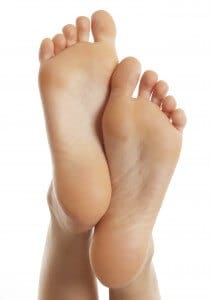
Smooth Feet, Getting Rid of Calluses, Moon Twp
How Are Foot Corns and Calluses Treated?
Both can be treated by removing the conditions that cause corns and calluses on the feet, which will reduce the friction that is causing your skin to harden.
Plantar warts on the foot are treated very differently- have the Podiatrist check it!
It’s important to remember that corns and calluses are not usually harmful (although those with diabetes should let their doctors know if skin begins to thicken on the foot). However, serious calluses and corns can become infected, affect foot movement or destroy healthy tissue. If that occurs, they’ll need to be removed.
With our help, calluses and corns can be monitored and controlled. There are certain medications and special exfoliating creams in our Beaver County Foot Doctors office and Butler County Foot Clinics that remove the dead skin that make up most corns and calluses. However, you should never try to cut or shave them off yourself—corns and calluses can become badly infected, especially if you are diabetic or have poor circulation.
What are the causes of calluses and corns?
Technically, both corns and calluses are forms of hyperkeratosis, which is the scientific term for thickening of the skin. This is one of the skin’s protective mechanisms, and corns and calluses are meant to shield the skin from chronic rubbing or pressure. Anything which causes friction or pressure has the potential to trigger this type of skin response.
By far, the main cause of corns and many types of calluses is improperly fitting footwear. Shoes or boots that are too loose, too tight, or have protruding seams or stitching can cause excessive rubbing. Foot abnormalities such as bunions, hammertoes, and bone spurs can also subject the feet to abnormal points of pressure and friction. Having an abnormal gait can contribute to these issues as well.
While corns are usually located on the feet it’s also possible for them to develop on the hands. Professionals who use tools daily such as carpenters and construction workers often develop hand corns, as do musicians.
Are Corns And Calluses Preventable?
Yes! With some preventive tips any type of corns and calluses are preventable.
But these problems are developed because we don’t care about our feet until we don’t develop a problem.
Therefore from next time take care of your feet.
Here are some of the most effective preventive tips for corns and calluses:
- Inspect Your Feet And Keep It Clean
Do not forget to inspect your feet daily since many people forget to do it!
Check your both feet daily, inspect between your toes and was them as well.
After coming back from work or after coming back home, wash your feet daily with warm and soapy water.
This will not only keep your feet clean but it will wash away bacteria and prevent infections.
Lastly, dry your feet after a fresh shower, and do not let moisture remain on your foot.
2. Don’t walk Barefoot
Don’t walk barefoot even if you are going just for a walk in front of your house, you don’t know what bacteria and germs are growing there.
It doesn’t matter where you go it’s essential to wear shoes or foot wear. Even at home try wearing socks.
Furthermore, many people don’t wear footwear in places like swimming pools, locker rooms or gyms.
But you should do this, because many bacteria live there!
3. Wear Comfortable Shoes
If you keep wearing your old and uncomfortable shoes then you are more likely to develop corns and calluses.
Why don’t you buy new shoes? Make sure they provide a lot of space and are comfortable to you.
They should be well-cushioned and shock absorbing too, so that you don’t develop injuries even at hard times.
For an extra layer of protection you should wear socks and if possible wear moisture wicking socks.
Corn and callus risk factors.
In reality, anything which causes excessive or abnormal friction on the feet, hands, or elsewhere can cause corns and calluses. They affect all age groups, yet are more common in patients 65 years of age or older. It is estimated that about 25 to 70% of people have some level of corn or callus development on the feet at age 70. The following is a list of common risk factors:
- Foot or toe deformities or other changes in foot anatomy
- A biomechanically altered gait
- Hammertoes
- Bunions
- Ill-fitting footwear
- Tool or instrument use that causes repetitive stress in a specific location
- Performing manual labor. Corns and calluses are extremely common among construction workers, farmers, and other physically demanding professions.
Give Beaver Valley Foot Clinic a call now to arrange an appointment for your painful calluses! Our podiatrist can treat the skin problems that affect your feet.
Call now for your consultation 878-313-3338 or Click Here to E-mail Dr. Christina Teimouri
Same day appointments available for emergency patients (even NEW PATIENTS)
- Podiatry practice for 23 + years and counting
- Locations near you in a Tricounty area
- American Board of Foot and Ankle Surgery Certified
- Non Surgical options for many foot problems available
- Immediate relief of corns and callouses!
FAQ’s about Corns and Calluses
Q. What is a callus?
A. A callous is hardened, area of thick skin found a pressure point where rubbing or friction occurs.
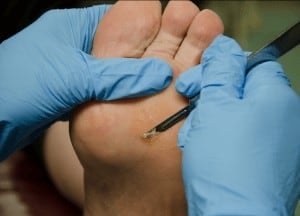
Picture of Podiatrist Removing Corns and Calluses Pittsburgh Pa
Q. What is the best callous treatment?
A. The safest and best callus treatment is found at your local Podiatrist in Butler County. Dr Teimouri DPM will shave down the callous gently and painlessly with a scalpel.
Q. What are some callous treatments I can try at home?
A. Popular home remedies for calluses include Pumice stones, sandpaper and moisturizing creams. FYI over the counter creams are not strong enough. Our podiatry office, Beaver PA and other locations carry much stronger options like 40% urea cream and keratalytic agents that slough off the dead skin with out damaging good skin. This is especially important in our Diabetic patients.
Q. I get painful cracks in my heel, what is the best treatment for cracked heels?
A. The best treatment for Cracked heel fissures is to #1 get a correct diagnosis from our Foot Doctor in Moon Twp or other locations as to the cause of the cracks, which are multiple. One cause may be tinea pedis, or athletes foot , causing the thick skin and cracks. The Foot Doctor can write a prescription to heal it in about 30 days. She can also shave the thick skin to prevent the cracks from going deeper.
Treatment of corns and callouses
One of the most common problems Podiatrist in Wexford treat are corns and calluses. Here are some FAQ our Cranberry Foot Doctor answers everyday to help you deal with your foot problem.
What is a callus? A callus is thickened hard skin that often form on the bottom of the feet in the outer layers of your skin.
What is a corn? A corn has a deep nucleus of hard skin in its center and is usually found on and between the toes, or on the bottom of the foot. These can be painful.
How to treat calluses:
- Shave the callus off (don’t try this at home)
- Apply OTC corn pads (not to be applied on or between toes!)
- Cut the corn out ( see your podiatrist)
- Pads to take away pressure
- Shoe inserts with area under callus cut out
- Fix the bone under the callus to take away the pressure (can be done in office!)
Callus treatment should be done by a Board Certified Podiatrist who has the proper sterile tools for removing foot corns and calluses on feet. Plantar calluses, which means hard skin on the bottom of the foot) are not always bad, you may even ask.”Are calluses good for you?” and the answer is sometimes yes.
If you are wondering how to get rid of calluses permanently, there’s only one way. This would be a simple office procedure to reduce pressure under the area. For example, How do you get rid of corns on your pinky toes? Lightly numb the toe, gently cut through the outer skin, then snip the little arthritic piece of bone and sew the area shut!
Can corns and calluses be removed permanently?
Corns and calluses can be treated and removed, but they may return if the underlying cause is not addressed. To remove corns and calluses permanently, it’s important to identify and address the factors that contribute to their development. This may include:
1. Proper footwear: Wearing properly fitting shoes that provide adequate support and cushioning can help prevent the recurrence of corns and calluses.
2. Foot mechanics: Addressing any issues with foot mechanics, such as flat feet or high arches, can help reduce pressure and friction on the skin, which can contribute to the formation of corns and calluses.
3. Regular foot care: Practicing good foot hygiene and regularly moisturizing the skin can help prevent the buildup of dead skin cells that can lead to corns and calluses.
How does age affect the risk of developing corns and calluses?
Age can affect the risk of developing corns and calluses in several ways:
1. Skin changes: As people age, their skin tends to become thinner and less elastic, making it more susceptible to damage from pressure and friction, which can increase the risk of developing corns and calluses.
2. Foot structure: Age-related changes in foot structure, such as changes in arch height or the development of deformities like bunions or hammertoes, can increase pressure on certain areas of the foot and increase the risk of corns and calluses.
Can corns and calluses be a sign of poor foot hygiene?
Corns and calluses are not necessarily a sign of poor foot hygiene. They are usually caused by repeated pressure or friction on the skin, often from wearing ill-fitting shoes or engaging in activities that put pressure on the feet. However, poor foot hygiene can contribute to the development of corns and calluses by allowing dead skin cells to accumulate, which can make the skin more susceptible to pressure.
How do you get rid of a soft corn? The same way!
What causes a callus?
How do you get rid of calluses on your feet?
removal of corns and calluses
can a podiatrist remove corns
remove calluses on feet
what is a callus on foot
how to remove corns on toes at home
remove corns from toes permanently
how to get rid of corns on toes fast
corn on foot treatment
how to get rid of a corn on bottom of foot
remove corns on feet overnight
what is corn disease
callus remover
What is a foot callus
for answers to all of these, go to our website and read more


